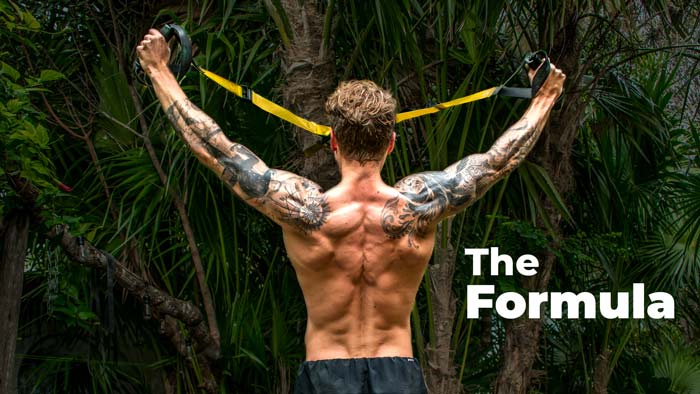
Here’s how I completely rebuilt my shoulders in my 30s without ever stepping foot in a gym again.
Years of heavy ego-lifting in my 20s gave me nothing but pain…
Until I switched to slow, controlled movements using just a TRX suspension trainer…
And built better shoulder mobility and strength in 1 year than in 8 years in a gym.

So in this post, I’m going to show you how the 3 exercises to build stronger, injury-resistant shoulders with a suspension trainer.
To start, let me show you how to get Complete 4D Shoulder Muscle Activation…
Don’t have time to read the post in full? Then watch the video below to learn how to build shoulders with a TRX…
Table Of Contents
4D Shoulder Muscle Activation
Like most guys in their 20s, I thought bigger weights meant bigger shoulders.
I chased ego-lifting heavy barbells until shoulder impingement left me wincing just putting on a t-shirt.
The problem wasn’t the weights themselves; it was that I was only training about 30% of my shoulder’s full range of motion.
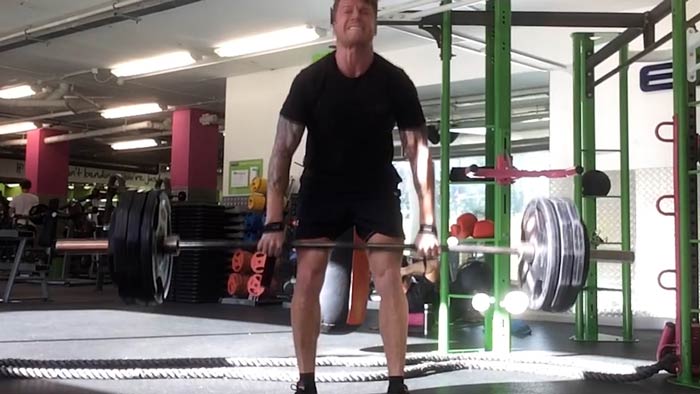
When I swapped heavy lifts for minimalist suspension training focused on muscle tension rather than weight:
- My shoulder pain vanished
- My posture dramatically improved
- I felt genuinely strong for family life and longevity, not just gym strong for ego.
Sounds too good to be true, right?
Well, let me show you exactly how I did it.
Here are the 3 suspension exercises and the specific muscle-centric technique that bulletproofed my shoulders.
TRX Shoulder Exercise 1 – Y Shape
First up is the “Y” raise, targeting your middle shoulder muscle.
One of the most powerful TRX shoulder exercises
This exercise builds a strong, functional foundation, but go too far back, and your upper back muscles take over, stealing tension from your shoulders.
Lean too far forward, and you’ll hang loosely through the joint, losing all shoulder tension.
Lose tension, lose growth. The key is constant, controlled tension directly on your middle shoulder muscle.
Here’s exactly how you do it:
- Start by raising your arms into a “Y” shape, elbows slightly bent.
- Take a small step backwards—nothing dramatic, form beats ego here.
- Slowly lower yourself for 2 seconds, stopping just before your shoulders lose tension at the bottom.
- Drive your arms up slowly by squeezing your shoulder muscles, taking another 2 seconds,
- At the top, pause and squeeze your shoulders as hard as you can for 2 full seconds, pulling against the anchor for extra tension.
Each rep should take 6 seconds.
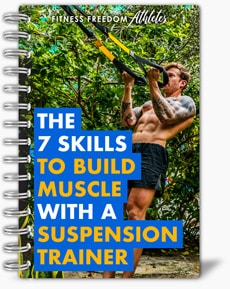
Get Your FREE Copy Of My ‘7 Skills To Build Muscle With A Suspension Trainer Handbook!’
Downloaded 70,000+ times! Just tell me where to send it:
TRX Shoulder Exercise 2 – T Shape
You can use this exact same technique for the “T” raise, targeting your rear shoulder muscles primarily and middle shoulders secondarily.
The only difference is arm position: arms parallel to the floor, elbows slightly bent. Again, avoid leaning too far forward or back.
Combining these TRX shoulder exercises into a superset is especially effective for building the burn.
Now, let’s tackle the front shoulder muscles with the suspension shoulder press.
TRX Shoulder Exercise 3 – Shoulder Press
This exercise requires a different technique, but before we get to that, you might be thinking…
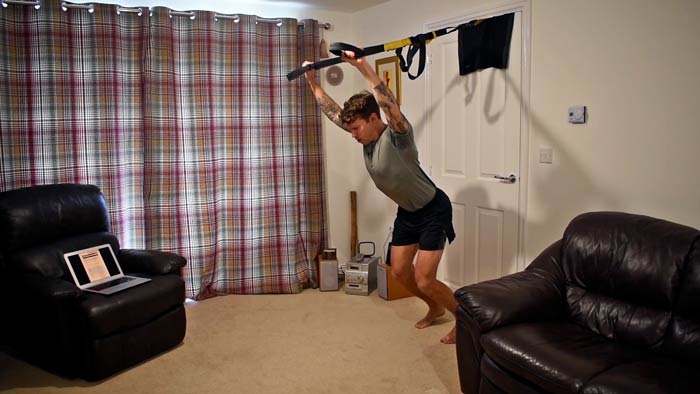
“There’s no weight here, this won’t do anything!”
But let me show you the critical focus that makes ALL the difference between a useless press and one that builds muscle
Here’s something I wish someone had told me years ago: Your muscles don’t understand weight—they only recognize tension.
When I stopped obsessing about lifting heavier and started focusing on building a strong mind-muscle connection, my shoulders grew faster than ever.
But how exactly do you build this “mind-muscle connection”?
It comes down to internal focus—really feeling the muscle you’re trying to work.
Let me show you.
Mind-Muscle Connection
Let’s revisit that suspension trainer shoulder press.
To get the most out of this, you need to let go of your old beliefs.
We’re not challenging the shoulders with weight, we’re challenging them with intentional tension.

Start by getting into an athletic stance, leaning slightly forward
Here’s the critical part—this is where your mind-muscle connection transforms a simple movement into powerful muscle activation.
Anyone can mindlessly press their arms up and down—that’s easy because your focus is only on the movement itself, not the muscle doing the work.
Instead, before you even move, squeeze your shoulders and arms as hard as you can.
Your arms should feel so tense they’re almost shaking:
- Now, keeping this intense squeeze, slowly press your arms up and slightly outward.
- Take a full two seconds for this upward movement.
- Stop just before your elbows lock out—locking out would release the tension, and we want to keep those shoulders working hard.
- Pause at the top and squeeze even harder for another two seconds.
- Then, slowly pull your arms back down, as if you’re dragging something heavy down with you.
- Resist gravity, and maintain that constant tension on your shoulders for another two seconds.
Now you’ve got the foundations for shoulder muscle development, let’s move on to how you can take this even further with strong shoulder stability.
Building Strong Shoulder Stability
Years of shoulder pain taught me one crucial lesson: stability is your insurance policy.
Think of your rotator cuff as the glue holding your shoulder firmly in place—it’s not flashy, but it’s essential.
But how do you build that stability?
Let me show you.
Your first stop: extended-arm plank holds using a suspension trainer.
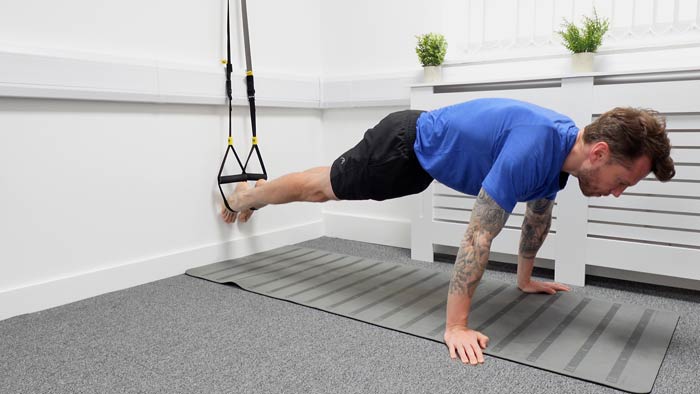
This simple exercise teaches your shoulders how to stay locked and stable under tension.
From there, you can level up to single-arm plank holds, challenging each shoulder individually.
I get it—these aren’t glamorous, social-media exercises.
But trust me, this is the difference between strong, pain-free shoulders and years of nagging discomfort.
If you want to spice things up, you can add leg movements to engage your core and increase instability, or even flow in and out of pike presses.
But honestly, that’s just getting fancy for fancy’s sake.
Stick to the basics—plank holds are your simplest, safest, and most effective route to rock-solid shoulder stability.
Bodyweight training often gets labeled as the “easy” option—but the truth is, it’s actually tougher.
It demands precise body control, sharp awareness, and most importantly, what I call “muscle-centric technique.”
In my TRX suspension Trainer Programs, I’ll show you exactly how I ditched the gym, combined this muscle-centric approach with a suspension trainer, and leveraged my mind-muscle connection…
to finally pack on lean muscle and completely transform my body.
Here’s to your Fitness Freedom
Coach Adam

 I hope you enjoy this post. If you want my help to build lean muscle & transform your body using a TRX suspension trainer anywhere –
I hope you enjoy this post. If you want my help to build lean muscle & transform your body using a TRX suspension trainer anywhere – 
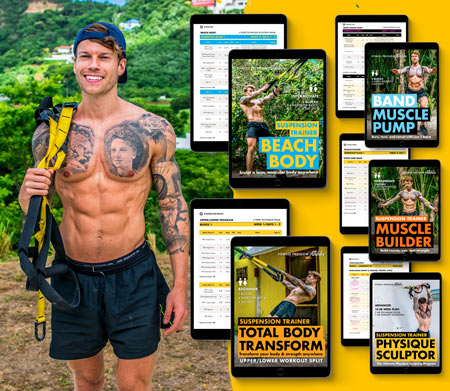

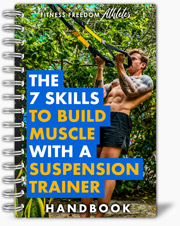
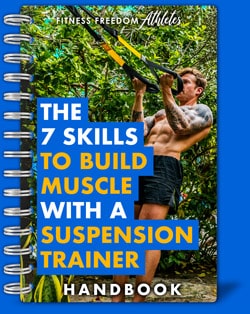

0 Comments